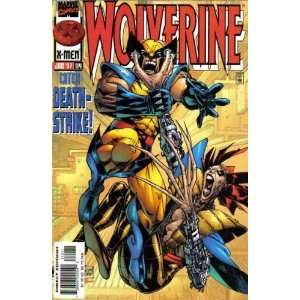When these artists started working, Wolverine was one of Marvel’s biggest stars. He got his own solo book in 1988 and was prominently featured in Fox’s long-running X-Men cartoon. Wolverine also appeared in his first solo video games Wolverine and Wolverine: Adamantium Rage in 1991 and 1994. In comics, this was a time of experimentation and changes for the character. He lost his adamantium skeleton to Magneto in X-Men 25 (1993), left the X-Men and became feral. His appearance changed to look more like Hugh Jackman from the X-Men films, his origin and true name James Howlett were revealed in Origin (2001-2), and he joined the Avengers and X-Force. He also began to randomly guest star in various titles leading to what is called “Wolverine Publicity” by TV Tropes.
Marc Silvestri (Uncanny X-Men from 1987-90; Wolverine from 1990-92; New X-Men in 2004)
Before he found Top Cow and left Marvel for Image with fellow X-Men penciller Jim Lee, Marc Silvestri cut his teeth drawing Wolverine in solo and team settings. His work on Wolverine’s solo title was commercially successful as he drew Wolverine’s conflicts with Japanese gangsters and even a cyborg version of himself. Silvestri assisted Chris Claremont with the “Fall of the Mutants” crossover in which Wolverine died and was resurrected with the other X-Men in Australia. His wackiest storyline was in Wolverine 35-37 where he and Alpha Flight member Puck met Ernest Hemingway (1991), and he also drew a future Wolverine in Grant Morrison’s final storyline on New X-Men.
Leinil Yu (Wolverine in 1997-99; X-Men in 2000-01;New Avengers in 2006-7; Ultimate Wolverine vs. Hulk in 2006-9; New X-Men Annual in 2001)
Out of all the artists so far (except for Windsor-Smith), Leinil Yu drew the most detailed, violent, and vicious Wolverine. Wolverine was the first assignment at Marvel for Leinil Yu, and he had a long run on the book even teaming with comic book legends Chris Claremont and Warren Ellis. His take on Wolverine was grim and world-weary, similar to Frank Miller’s in the 1982 miniseries. He also drew Wolverine as Death, Horsemen of Apocalypse in Wolverine 145 in which he fought Hulk (1999). Yu also worked with Lost creator Damon Lindelof on a much delayed, extremely violent miniseries called Ultimate Wolverine vs. Hulk. A memorable image from this book was Wolverine being ripped in half by Hulk and slowly “healing” his legs back.
Adam Kubert (Wolverine in 1993-96; X-Men in 1998-99;Uncanny X-Men in 1999-2000; Ultimate X-Men in 2001-3; Astonishing Spider-Man and Wolverine in 2010-11; Avengers in 2013)
A fixture on Wizard‘s top ten creators list, Adam Kubert has drawn almost every superhero in the Marvel and DC universes. While working on Incredible Hulk, he created a “pencils to color” art technique that was perfected in his run on Ultimate X-Men. Kubert and Mark Millar were chosen to revamp the X-Men for the Marvel’s new Ultimate Universe and gave Wolverine a new costume and attitude. Like Byrne, he drew Wolverine as much older than the rest of the X-Men, but with a black leather costume, like in the films. Kubert and Millar’s Wolverine started out as a villain and only joined the X-Men to get in Jean Grey’s pants. Kubert also drew a prehistoric Wolverine for the alternate universe miniseries Astonishing Spider-Man and Wolverine.
John Cassaday (Uncanny X-Men in 1998; Astonishing X-Men in 2004-08; Uncanny Avengers in 2012-13)
Another notoriously slow penciller, John Cassaday brought an illustrator’s touch to his version of Wolverine, especially in his run on Astonishing X-Men with Buffy the Vampire Slayer creator Joss Whedon. Abandoning the black leather, he returned Wolverine to his blue and yellow spandex costume as drawn by Dave Cockrum. In Astonishing X-Men, Cassaday and Whedon didn’t use Wolverine as a lead character, but made him a source of conflict on the team and good for a spot of violence. Cassaday also did an excellent job drawing Wolverine in action, such as his wordless splash page of Colossus and Wolverine executing a “fastball special” in Astonishing X-Men 6. Though he hasn’t drawn Wolverine as much as Yu or Kubert, Cassaday’s nostalgia tinged take on the character earned him three Eisners in 2005 and 2006.
Steve McNiven (New Avengers in 2005-06; Civil War in 2006-07; Wolverine in 2008-09)
Unlike most of the artists on this list, Steve McNiven got his start drawing Wolverine as a member of the New Avengers with Brian Michael Bendis. He has never penciled a single X-Men comic. However, he was the artist on the best and most violent Wolverine storyline “Old Man Logan”. His aging, pacifist Wolverine was modeled after Clint Eastwood in Unforgiven and didn’t pop his claws (except in flashbacks) until the last issue. McNiven’s Wolverine is actually believable as a farmer and family man, but there is still plenty of action and suspense despite the last of snikts. Despite his relative lack of experience drawing Wolverine, McNiven is on the top ten list because he drew Wolverine in the most creative way.
Honorable Mentions:
Art Adams (Uncanny X-Men Annual), John Romita Jr. (Uncanny X-Men), Frank Quitely (New X-Men), Andy Kubert (Wolverine: Origin), John Buscema (Wolverine), Steve Dillon (Wolverine: Origins), Frank Cho (Savage Wolverine), Darick Robertson (Wolverine), David Finch (Ultimate X-Men)







